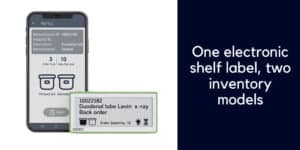What’s inside:
Managing the surgical supply chain in operating rooms and procedural labs is no easy task.
In fact, the complexity of surgical inventory combined the limitations of traditional systems, result in nurses failing to routinely record every item consumed before the end of surgery.
This blog will look at:
- The challenges faced by nurses in documenting surgical utilization into the electronic health record (EHR)
- The cross-organizational impact of bad OR data.
- The value of automating logistical workflows in the clinical, procedural and lab settings, in order to ensure the continuous supply of surgical supplies.
Reducing nurse involvement in surgical supply chain admin
Manual and outdated inventory management systems in ORs and procedural labs is placing a heavy burden on circulatory nurses and the lack of accurate point of use consumption data is affecting supply chain performance.
Perioperative nurses are responsible for managing inventory, including high-cost items, at the point of care. They need to juggle this additional responsibility alongside supporting the clinical team and keeping an eye on the patient. This task is further complicated by the fact that the tools available to support product usage documentation are ineffective, failing to achieve the automated documentation of every item consumed in surgery.
The limitations of point of use systems and processes results in elongated admin workarounds in an effort to collect product usage data and document utilization. These include:
- Struggling with barcode readability issues
- Dealing with system errors triggered by items not finding a match in the system
- Manually fixing incomplete or incorrect records
- Manually keying-in data where automation has failed
- Double-entry processes due to system siloes.
- Under-optimized clinical workflows due to clunky technology
The burden of supply chain administration on nurses causes them frustration and distracts them from patient care.
Managing Bill-Only and Consignment Inventory
The surgical supply chain is quite complex. One common issue in operating rooms and procedural labs is that the medical devices and implants used are a mix of owned stock, consignment inventory, and bill-only products (such as trunk stock).
These items are notoriously hard to reconcile, particularly as they may not have an associated purchase requisition and are often not even listed in the Hospital Item Master, or if they are listed, the data could be old.
Traditional point-of-use systems, including POU barcode scanning technology, commonly struggle with these types of items and nurses often end up laboriously keying in the data for these products.
When consumption data is not full or accurate it has an impact on efficient procurement, as the hospital materials management team end up basing procurement decisions on partial data and are unable to gain an accurate view of demand.
Achieving a Perpetual Inventory
The key to achieving a perpetual inventory in OR and procedural areas, that is, ensuring the continual supply of the items required for surgery, is to gain full visibility of procedural room and operating room inventory – both the items in stock and the items consumed.
The relationship between the collection of accurate product usage and the maintenance of a perpetual inventory are inextricably linked.
Healthcare providers are increasingly looking to install an automated point of use system to track every type of item consumed in surgery. They are looking to gain full inventory visibility at the point of care, and to streamline clinical workflows. Their end goal is for prompt and accurate surgical consumption data in order to achieve more informed procurement.
New technology is enabling fully automated inventory management in the surgical setting and the means to capture consumption, track OR inventory and produce key OR data to support enhanced healthcare management.
Why Point-of-Use Consumption Data is Business Intelligence
Point of use surgical utilization is key OR data that feeds into the internal workflows and support operational efficiency.
Full visibility of surgical utilization can support a wide range of organizational activities:
| Benefit of POU Technology | The Impact of Precise Product Tracking at the Point of Care |
| Data, analytics and insights | Data-driven supply chain management, with transparency and trust between supply chain partners. |
| Evidence-based PPI standardization | Indisputable data supports discussions on evidence-based PPI standardization – physician preferred items are some of the most expensive used in an organization, so working on this issue can pay deep dividends. |
| Improved vendor management | Precision product usage data helps healthcare organizations with vendor reconciliation, contract management and the negotiation of improved terms. |
| Optimizing case costs | When the EHR is complete and correct, accurate charge capture supports optimized case costing and medical billing. This optimizes OR revenue without additional resources being required. |
| Improve clinical integration into the supply chain | Integrated supply chain management improves communication, collaboration and performance between clinical and supply chain staff. |
| Achieving a ‘right-size’ inventory | Item-level tracking provides inventory vision and accurate demand assessments, informing healthcare inventory management and putting an end to unnecessary surpluses and stockouts. Full data will reduce the on-hand inventory value as well as the storage footprint. |
| Cost reduction | Accurate POU utilization data helps organizations tackle areas of inefficiency, such as product variation, where there are less expensive comparable products available. It also highlights the stock items that rarely or never get used. Good quality data supports inventory cost reduction and the achievement of a reduced inventory. |
| Patient safety | Patient safety is safeguarded by accurate medical records and the efficient handling of implantable medical device recalls. |
| Management planning | Point of care consumption data is business intelligence which improves management’s understanding of how OR is functioning, enabling smart data-based decisions for supply chain management, as well as forecasting for the future. |
| Benchmarking | Accurate data supports healthcare supply chain benchmarking such as the cost of procedure and cost per physician, which will ensure quality improvements and cost reductions. |
| Supply chain automation | The point of use is the weak point of many inventory management systems, so getting a custom-tool that works well in the surgical setting will result in a fully automated inventory management system that delivers good, timely data. |
| Clinical confidence and OR efficiency | The clinical team will be able to rely upon accurate stock levels, ensuring that surgeries run on time and cases aren’t cancelled due to product shortages. |
The surgical inventory used in operating rooms and surgical environments is commonly the second largest expense of a healthcare organization (after staff).
Consumption data is a vital tool to understand the real supply chain requirements of the organization. Once there is transparency into product usage in surgical spaces, organizations are better equipped to reduce costs, improve patient care, and optimize OR efficiency.
Streamlining Surgical Supply Management with Point-of-Use Technology
IDENTI has developed a first-of-its-kind custom-fit data collection tool for the point of use, that uses the powerful combination of image recognition technology, backed up by an AI system.
Snap&Go is a unique POU solution for the automatic tracking of product usage. This brand-new approach to surgical supply data collection transforms POU data capture into a 3 second task.
The nurse simply takes a quick ‘snap’ of each product packet or label by placing it under a computer sensor. The system then ‘reads’ the image and turns it into digital data. This cutting-edge technology marks the start of the image to data revolution.
No other system comes close to the data outputs of image-recognition and AI, and here’s why:
- EVERY reportable, billable item used in surgery can be captured whether it’s:
- A stock item
- Consignment inventory
- A Bill-Only product
- A small consumable without a barcode or packet
- FULL DATA is captured – UDI, batch number, lot, expiry date – no need to fix anything or add missing data.
- AUTOMATED item identification is via a globally-populated SKU database which acts like your virtual item master – dealing with items that don’t find a match in your own system. There’s even a human back-office as a final safety net, to ensure none of your staff need to be involved in this task.
- DOCUMENTATION is seamless – all consumption data feeds straight into your EMR, ERP, and MMIS systems, making sure that valuable usage data feeds promptly into vital operational workflows.
- DATA in the form of real-time metrics, reports and analytics are produced to ensure this vital data point delivers the business intelligence that management need to make smart decision.

Snap&Go is a unique custom-solution for the point of care using AI technology and computer vision.
This brand-new method of capturing and documenting surgical product utilization reduces the burden placed on nurses while achieving 100% item and data capture at the point of use.
Managing and tracking surgical supply items in OR and Procedural Labs is now easily achievable, supporting the enhanced delivery of high-quality healthcare.
Contact us to find out more about the image-data revolution, or any of our automated inventory management solutions. .






